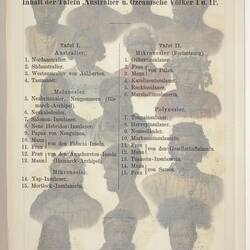Summary
Full colour chromolithograph featuring images of people representing various Australian and Oceanic cultural groupings. Published in the Brockhaus Konversations-Lexikon, Leipzig, Germany, 1892-95. It is signed by the artist G. Mutzel. Chromolithographs are coloured pictures printed by the lithographic process from a series of stone or metal plates, the impression from each plate being in a different colour.
The Brockhaus Lexikon is a German-language encyclopaedia. The first edition by Renatus Gotthelf Löbel and Christian Wilhelm Franke, was published in Leipzig, 1796-1808. Similar to other 18th century encyclopaedias, the scope was expanded beyond that of earlier publications, in an effort to be more comprehensive. It included geography and history, as well as the more typical mythology, philosophy and natural history subject areas. At first the name of the encyclopaedia remained Konversationslexikon or Allgemeine deutsche Real-Encyklopädie für die gebildeten Stände ('General German encyclopedia for the educated'); only with the 13th edition did the name Brockhaus appear in the title, and the present edition is titled Brockhaus Enzyklopädie. This chromolithograph is from the 14th edition published in 1892-95, featuring 18,842 pages in 16 regular volumes and one supplement volume.
Physical Description
Full colour chromolithograph featuring 14 images of people representing various Australian and Oceanic cultural groupings. Each person has been identified by a numbered key at the bottom of the illustration. The illustration is titled: 'Australische Volkertypen.'
Significance
This illustration demonstrates the popular forms of scientific representation by European scientists in classifying Indigenous peoples into racial groupings.This is at a time, around the turn of the 20th century when scientific debate around Darwinism was also being influenced by other less scientific theories including eugenics and phrenology which all contributed to a white western social hierarchy which placed Indigenous peoples at the bottom of the social and intellectual pecking order. Whilst these depictions are 'straight' and without stereotype or denigration, they still imply a primitive and less civilised nature which continued to fascinate white Western societies.
More Information
-
Collecting Areas
Migration & Cultural Diversity, Science & Measurement, Images & Image Making
-
Acquisition Information
Purchase
-
Printer & Publisher
-
Inscriptions
Footer: Brockhaus Konversations-Lexicon. 14 Aufl/E.A.Brockhaus Geogr-artist Anstalt Leipzig Heading (German): Australische Volkertypen Key: 1 Fijians; 2 Tasmanians; 3 South Australian; 4 Maori (New Zealand); 5 New Britons; 6 Tattooed Samoan Islanders; 7 New Irishman (Buk-islands); 8 Caroline Islander (Ponape); 9 Admiralty islander; 10 Tonga Islander; 11 New Irishwoman; 12 Samoan Islander, Papua; 13-14 Marshall Islander, male, female (Jaluit).
-
Classification
-
Category
-
Discipline
-
Type of item
-
Overall Dimensions
160 mm (Width), 250 mm (Height)
-
Keywords




